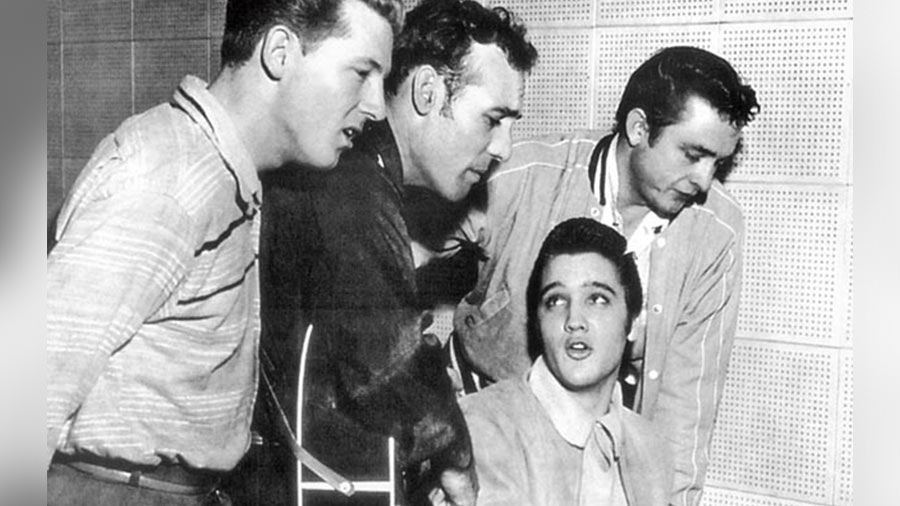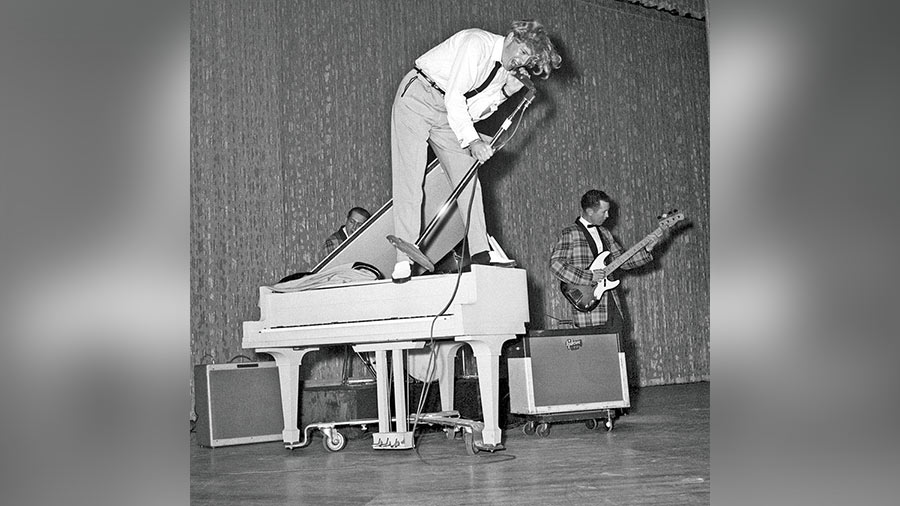Jerry Lee Lewis has packed his bag to have a Million Dollar Quartet gig in the sky. He leaves behind music that’s celebrated for its pounding piano and uninhibited style of singing. He was also one of the founding pillars of what we celebrate as rock ’n’ roll.
On November 21, 1955, Sam Phillips, the owner of Sun Records — the record label where rock ’n’ was moulded — sold Elvis Presley’s contract to RCA so that “his talents can be given the fullest opportunity”. The truth was Phillips needed money and after selling the contract, he needed someone to succeed Presley, someone whose music could create a storm.
Enter Jerry Lee Lewis whose first session at Sun Records was in November 1956. He had already unsuccessfully auditioned to be a backup for Slim Whitman at the Louisiana Hayride in Shreveport, a regional competitor of Nashville’s Grand Old Opry. By then he had heard Presley’s music, so he decided to make a trip to Sun Records. The session resulted in two songs — End of the Road, which Jerry had written for himself, and Crazy Arms. Sun did what it always managed to do well — package talent. The singer was billed as Jerry Lee Lewis and His Pumping Piano. The songs didn’t chart but Sam Phillips felt there was something unique about Jerry. He was invited back for more sessions. And then magic happened.
The Million Dollar Quartet
December 4, 1956. Elvis Presley, Jerry Lee Lewis, Carl Perkins and Johnny Cash — four legends — were at Sun Records and soon it became a jam session by pure chance. Perkins, who by then had already met success with Blue Suede Shoes had come into the studios, accompanied by his brothers Clayton and Jay and by drummer W.S. Holland; the aim being to cut some new material. Phillips tried to flesh up the sparse rockabilly instrumentation by bringing out his latest sign up — piano man extraordinaire, Jerry Lee Lewis, still unknown outside Memphis.
Sometime in the early afternoon, Presley dropped in to pay a casual visit accompanied by his then girlfriend Marilyn Evans. After chatting with Philips in the control room, Presley listened to the playback of the Perkins’ session and then he went into the studio. Soon, the jam session began. Phillips left the tapes running to “capture the moment”. At some point during the session, Sun artiste Johnny Cash dropped in. The following day, newspaperman Bob Johnson’s article appeared in the Memphis Press-Scimitar under the title, Million Dollar Quartet. The rest is history and Jerry didn’t have any reason to look back.
The next few years was packed with hits from Jerry, a Louisiana tenant farmer’s son and the cousin of televangelist Jimmy Swaggart — Great Balls of Fire, Breathless, Whole Lotta Shakin’ Goin’ On and High School Confidential, to name a few. He became famous for his lightning moves up and down the keys with his right hand and speeding up the tempo mid-song and then finishing onstage by standing on the piano.
His music was a delicious synthesis of rhythm and blues, country, gospel, and boogie-woogie. No wonder he was called “The Killer” and was respected by his colleagues. His Rock & Roll Hall of Fame biography describes him as “the wild man of rock and roll, embodying its most reckless and high-spirited impulses”.
Rolling with the punches
When Lewis burst on the music world, he sounded like a man from another planet. His family was a product of the Deep South while his childhood wasn’t an easy one. After he showed an interest in his uncle’s piano at the age of eight, his father Elmo mortgaged the family house to buy Jerry an upright Starck. He soon mastered Silent Night in a boogie-woogie style. It was also a time when the family went through hardship. His younger brother died and his father was taken to prison on a moonshine rap. “He made the best whisky I ever tasted, drunk it all the time,” he had said in a 1980s interview.
The latter part of the 1950s belonged to him. On a day trip to Los Angeles, he got to spend an afternoon with Elizabeth Taylor (and her husband) on the lot at MGM and later they had dinner: “I ain’t never seen a woman that beautiful in my life. I’ve seen a lot of other woman, but that one took the cake,” he said. Next, he shared a marquee with Sam Cooke, who called him “cousin”. And he left Liberace speechless with his style of playing the piano.
But good times didn’t last long. The tabloids revealed he had married his underage second cousin Myra Gale Brown. When he decided to embark on a tour of England in 1958, the tabloids learned of the “child bride” accompanying him (also that he was married to his second wife when he had recited the vows for his marriage with Myra) and the reports were extremely revealing of what Jerry thought of marrying someone underage. His career recovered after a few years but it wasn’t the same ever again. Concert dates dried up and radio stations refused to play his music. Reduced to playing small clubs and having to leave Sun Records, he found a new path with country-tinged music. Smash Records signed him in 1963. What followed were up-tempo honky-tonk numbers. Success once again found him with hits like Another Place, Another Time, What’s Made Milwaukee Famous (Has Made a Loser Out of Me), She Still Comes Around (to Love What’s Left of Me) and To Make Love Sweeter for You.
The good times ran out, yet again. Years of heavy elbow bending took its toll, there were run-ins with the IRS and the police and then his troubled son, Jerry Lee Jr. died in a car crash in 1973. Three years later, while watching TV, he accidentally shot his bass player, Norman Owens, in the chest with a .357 Magnum handgun after announcing, “I’m going to shoot that Coca-Cola bottle over there or my name ain’t Jerry Lee Lewis.” Owens survived but Jerry’s finances took a hit. In 1976 he turned up at Presley’s house, Graceland, drunk and waving a gun.
Jerry lived on the edge and newspapers kept tributes ready in the 1980s. In 1981, after operations on multiple stomach ulcers, pneumonia set in, and doctors gave him a five per cent chance of survival. “I thought I was dead, as a matter of fact. I knew that it was over for me. When I hit the floor and my stomach split open, I had enough sense to get my house in order with God,” he said.
The singer held himself back only in the late 1980s. His career got another boost in 1989 when he sang his songs for the movie Great Balls of Fire! in which Dennis Quaid portrayed him while Winona Ryder played Myra. Then in 2006, he took the help of such admirers as Mick Jagger, Keith Richards, Kris Kristofferson, Willie Nelson and Buddy Guy for his 2006 release Last Man Standing.
How does one remember Jerry Lee Lewis? In 1981 he told Goldmine: “I’m the only one left who’s worth a damn. Everyone else is dead or gone. Only the Killer rocks on.” That’s true. Sure, he led a troubled, on-the-edge life but when it came to rock ’n’ roll, compromises were not made. He will always be remembered as the wild man of rock, one who always stirred up a storm with his best friend, the piano.

(From left) Jerry Lee Lewis, Carl Perkins, Elvis Presley and Johnny Cash — the Million Dollar Quartet photo from 1956
Jerry Lee Lewis (September 29, 1935 — October 28, 2022)
On A Roll
Great Balls of Fire (1957): ‘Sexuality’ and ‘liberation’ are the two words that define the 1957 Jerry Lee Lewis song. His live performance of the song dripped with sexuality, making him a key figure of early rock music. It remained his signature tune.
Whole Lot of Shakin’ Going On (1957): Originally recorded in 1955 as a swinging blues by Big Maybelle, it is the Lewis number we remember as he made the piano take center stage.
Boogie Woogie Country Man (1975): It was the 1970s and the singer proved that he wasn’t done making good music. “I like to do me a little rock, do me a little roll/ Country boogie woogie God is deep down in my soul,” he sings on the stomper. Don’t go by the title because it’s pure rock ’n’ roll.
Who Will the Next Fool Be (1979): The Charlie Rich song has been covered by soul singers but Jerry gave the song a twist on his self-titled 1979 album, with a studio band that included guitar great James Burton. Of course, he lets the piano shine.
Over The Rainbow (1980): Nobody expected him to turn a standard from The Wizard of Oz into a country waltz. He played it straight and the piano was irrepressible.
